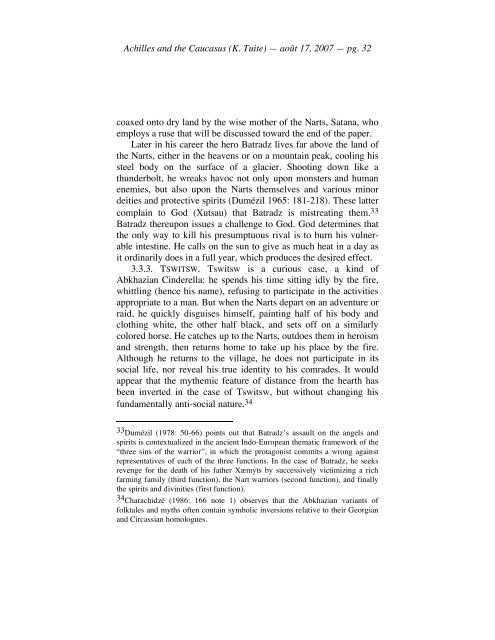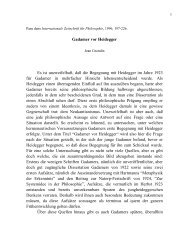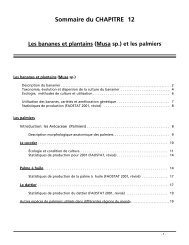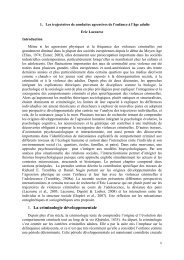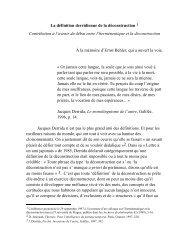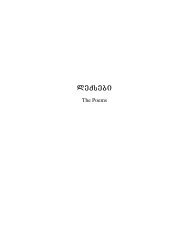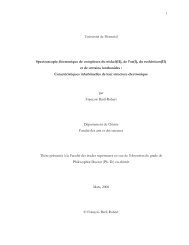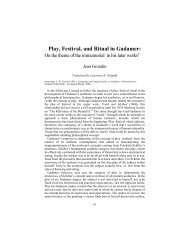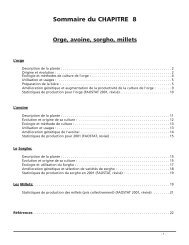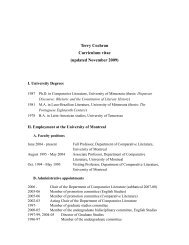Achilles and the Caucasus - Université de Montréal
Achilles and the Caucasus - Université de Montréal
Achilles and the Caucasus - Université de Montréal
Create successful ePaper yourself
Turn your PDF publications into a flip-book with our unique Google optimized e-Paper software.
<strong>Achilles</strong> <strong>and</strong> <strong>the</strong> <strong>Caucasus</strong> (K. Tuite) — août 17, 2007 — pg. 32<br />
coaxed onto dry l<strong>and</strong> by <strong>the</strong> wise mo<strong>the</strong>r of <strong>the</strong> Narts, Satana, who<br />
employs a ruse that will be discussed toward <strong>the</strong> end of <strong>the</strong> paper.<br />
Later in his career <strong>the</strong> hero Batradz lives far above <strong>the</strong> l<strong>and</strong> of<br />
<strong>the</strong> Narts, ei<strong>the</strong>r in <strong>the</strong> heavens or on a mountain peak, cooling his<br />
steel body on <strong>the</strong> surface of a glacier. Shooting down like a<br />
thun<strong>de</strong>rbolt, he wreaks havoc not only upon monsters <strong>and</strong> human<br />
enemies, but also upon <strong>the</strong> Narts <strong>the</strong>mselves <strong>and</strong> various minor<br />
<strong>de</strong>ities <strong>and</strong> protective spirits (Dumézil 1965: 181-218). These latter<br />
complain to God (Xutsau) that Batradz is mistreating <strong>the</strong>m. 33<br />
Batradz <strong>the</strong>reupon issues a challenge to God. God <strong>de</strong>termines that<br />
<strong>the</strong> only way to kill his presumptuous rival is to burn his vulnerable<br />
intestine. He calls on <strong>the</strong> sun to give as much heat in a day as<br />
it ordinarily does in a full year, which produces <strong>the</strong> <strong>de</strong>sired effect.<br />
3.3.3. TSWITSW. Tswitsw is a curious case, a kind of<br />
Abkhazian Cin<strong>de</strong>rella: he spends his time sitting idly by <strong>the</strong> fire,<br />
whittling (hence his name), refusing to participate in <strong>the</strong> activities<br />
appropriate to a man. But when <strong>the</strong> Narts <strong>de</strong>part on an adventure or<br />
raid, he quickly disguises himself, painting half of his body <strong>and</strong><br />
clothing white, <strong>the</strong> o<strong>the</strong>r half black, <strong>and</strong> sets off on a similarly<br />
colored horse. He catches up to <strong>the</strong> Narts, outdoes <strong>the</strong>m in heroism<br />
<strong>and</strong> strength, <strong>the</strong>n returns home to take up his place by <strong>the</strong> fire.<br />
Although he returns to <strong>the</strong> village, he does not participate in its<br />
social life, nor reveal his true i<strong>de</strong>ntity to his comra<strong>de</strong>s. It would<br />
appear that <strong>the</strong> my<strong>the</strong>mic feature of distance from <strong>the</strong> hearth has<br />
been inverted in <strong>the</strong> case of Tswitsw, but without changing his<br />
fundamentally anti-social nature. 34<br />
33 Dumézil (1978: 50-66) points out that Batradz’s assault on <strong>the</strong> angels <strong>and</strong><br />
spirits is contextualized in <strong>the</strong> ancient Indo-European <strong>the</strong>matic framework of <strong>the</strong><br />
“three sins of <strong>the</strong> warrior”, in which <strong>the</strong> protagonist commits a wrong against<br />
representatives of each of <strong>the</strong> three functions. In <strong>the</strong> case of Batradz, he seeks<br />
revenge for <strong>the</strong> <strong>de</strong>ath of his fa<strong>the</strong>r Xæmyts by successively victimizing a rich<br />
farming family (third function), <strong>the</strong> Nart warriors (second function), <strong>and</strong> finally<br />
<strong>the</strong> spirits <strong>and</strong> divinities (first function).<br />
34 Charachidzé (1986: 166 note 1) observes that <strong>the</strong> Abkhazian variants of<br />
folktales <strong>and</strong> myths often contain symbolic inversions relative to <strong>the</strong>ir Georgian<br />
<strong>and</strong> Circassian homologues.


